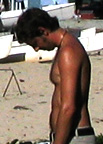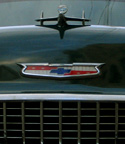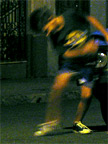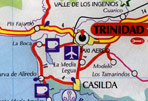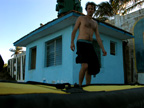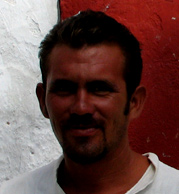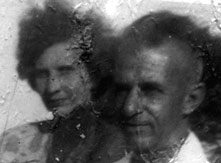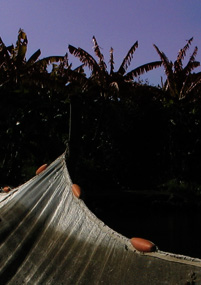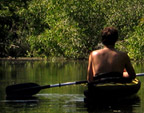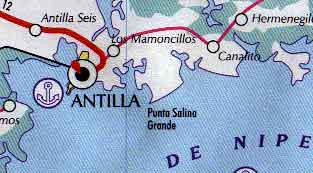Tuesday, November 30, 2004
Saturday, November 13, 2004
Part 8 - Rancho Luna to La Boca, Trouble with el Ministerio del Interior (Part 2)
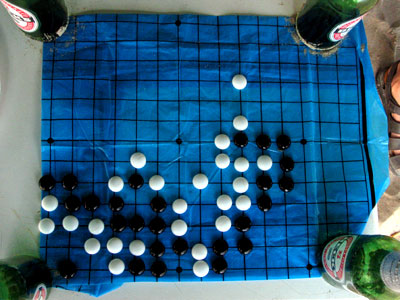
We’d already been in Cuba for nearly two weeks, but it was only at Rancho Luna that we finally found ourselves on a real beach. We decided to take a day off there and reanalyse our situation. You will recall that in Gibara, Fisherman Buddy had warned us that we’d surely be stopped if we tried to leave the bay there, and in Cienfuegos we’d proven it. But the officer at the Frontera there had been so optimistic about our chances of gaining permission by applying at the International Marinas en route that we were quite keen to find one in Rancho Luna and try our luck.
As you will undoubtedly have guessed, there was no "International Marina" in Rancho Luna. We went to the little unmarked police station, much to the confusion of the officer on duty there, and we also went to the local dive shop, but no one in the village seemed to have the authority to grant us our permission, nor a clue as to what we were talking about.
On the other hand, this also seemed to indicate that no one had the authority to prevent us from paddling. Typically convenient specious logic, perhaps, but this is precisely the kind of thinking that had gotten us as far as we had.
Both for the sake of exploration and to see if anyone would object, on our second day in Rancho Luna we paraded all the way across the bay and up the river that empties into it on its far east side. This was, of course, not before enquiring several times with river fishermen about crocodiles.
The river was not navigable for more than a few kilometres, at which point it became hopelessly clogged with water plants, but neither on the way there nor on the way back did we see any official-looking posts or people, and certainly no one commandeered any boats to come and molest us. We happily concluded that that must be something that only occurs at major ports, and so we figured we could probably head right on out the next day and start going along the coast. If we got caught again we could just say we were perfectly aware we needed to get permission from an International Marina, and that we were actively seeking one out, and what better way than from the water? A ridiculous argument, but we counted on whoever caught us thinking we were stupid foreigners.
Besides, given the absence of one of these centres for marine empowerment in Rancho Luna, we surmised there probably wouldn’t be another until Casilda, the port nearest to the city of Trinidad.
The next morning we set out, but we experienced some frustrating delays packing. Our boats were stilled assembled from our little river exploration, which we thought would save us time, but the business of packing Jay’s guitar within the Pro Pack within the awkward holds of the Cooper kayak went differently than when the boat had been assembled around the packed guitar. In the end the Pro Pack and the guitar inside were strapped to the deck of Jay’s kayak, and I was happy for the delay because it gave the unreliable bread delivery guy time to find us on the beach and send us off with some of his fluffily flavourful yeasty feast.
And so, thus packed and tucked out, we set out for the sea again. The winds were low, and before long we’d cleared the bay. Rounding the point, our paddles dipped into the Caribbean itself, for the first time.
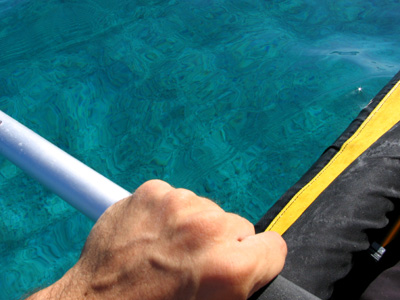
The water was perfectly transparent, and the sea bed was clearly visible: mostly white sand interspersed with intriguing patches of coral reef. The shoreline was long and straight, consisting almost exclusively of sharp, porous rock, and entirely inhospitable, looking as if it would shred any boat, let alone a skin-and-frame fold-up. There was a steady, large swell that would slowly bob us in and out of sight of each other. We shouted nervous jokes about how disastrous it would be if the weather took a bad turn: there was nowhere safe to land and the shore was quite exposed to the sea’s whimsy.
As it was, though, made for fantastic paddling, and after two or three hours we were rewarded with one of the coastal kayaker’s dreams turned into reality: an unspoilt and accessible-only-by-kayak beach.
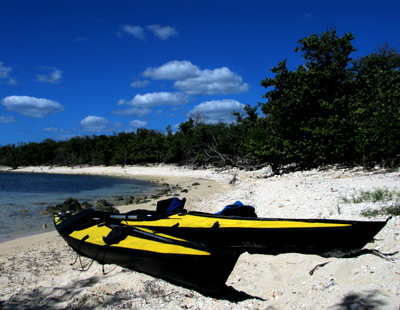
It was populated only by a spear-fisherman patrolling the extensive coral there for fish and lobster. He had walked several miles from the road to hit the richness of the reef there. Plus, lobster fishing is mostly illegal: the state wants to control its reserves and serve it only to foreigners to keep its value high. The same is done with beef, but cows are harder to hide, I’ll bet. The spear-fisherman left soon after we arrived, having worked all morning and made a satisfactory catch.
We snorkelled there for a long while, amongst the architecturally labyrinthine coral, then we ate and relaxed in the shade. We didn’t know how far it was to the next place we’d be able to stay, but we thought we knew there’d be something at a place along there called Gaujimoco. Failing that, there was reputedly some sort of concrete shelter available for camping at Playa Ingles, further on. All distances were indeterminate. We couldn’t have been happier.
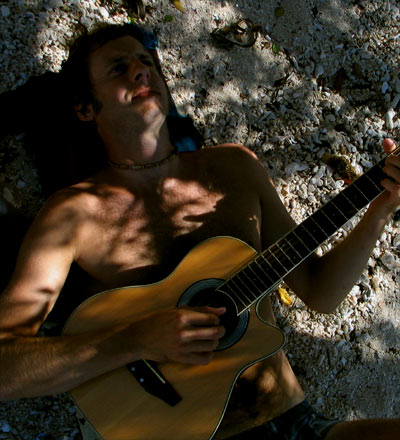
We set off again, and before long the rocks along the shore began to rise higher and we were regaled with dramatic cliff faces. At one point where the cliffs were particularly exquisite, there was a little inlet finishing snugly on a little beach. There were some smaller buildings up top on the left side of the inlet, a thin trail of smoke, and one man tending the fire, his back to the sea.
On the other side, perched high and arranged facing the sea, was some sort of extensive building complex. At some point in history, it had clearly been luxurious. It was difficult to say what its story was, what it was doing there.
As we turned in, we passed far under an old cable hanging from one cliff top to the other. It looked as if it had once held together a suspension bridge. Now people wishing to commute from one side to the other were obliged to descend steps carved into the rock all the way down to the cozy beach where Jay and I landed.
I reckoned that it used to be some rich mafia dude’s Cuban palace, and since then it had become a state-run resort. It didn’t surprise me that there was no one on the beach, for some reason. Low season? In any case, the right-hand or southern steps clearly lead to where the action was, so up we clambered. We didn’t really want to leave our kayaks alone, but neither of us could quell their curiosity enough to stay below with them.
By the time we’d made it to the top we could hear the dance music which was blaring from speakers near a swimming pool where young women in bikinis ran and splashed about. Two men surveyed the beatific scene, their backs to us.
After we garrotted the men, we took the women as our harem and installed ourselves in the mansion. We live there still.
Actually, we hailed the men, and one of them turned around. He had been in the middle of enjoying a joke with his companion, but his face dropped on seeing us, and he jabbed the other in the ribs with his elbow. They approached with sternly confused faces, and we approached bidding them jolly buenas tardes.
They demanded to know how we’d gotten there. Had we come on foot?
We owned up that we’d come by boat, and parried with "What is this place? A hotel?" (All our converse in poor Spanish.)
No, they replied, looking at each other, it’s a military base, and what boat?
Which is about when we started reversing direction. "Military, eh? Heh, heh. This is not Gaujimico? Heh... Yeah, which way is it to Gaujimoco, if you please, dear sirs?"
That distracted them a moment. The trick was to make sure they didn’t have time to realize that they should detain us and fetch an officer who might give us some cold war style grief. Or maybe these two were officers? What kind of base was it, anyway, with girls prancing around half-naked? How do we join the Cuban army?!
They began arguing about exactly how many more coves one had to pass going down the coast before one arrived at Gaujimoco. This was just before we redescended the stone steps to our boats. It is easy to imagine just how eager we were to get the heck out of there before someone with a more paranoid imagination came along, and the tension mounted as Jay had to fiddle with something or another before we could split. Meanwhile, the man who’d been tending to the fire on the other cliffside had noticed the little gathering and seemed to be racing down his steps to get to us.
But, he was just a fire-keeper type, and not a sadistic freelance inquisitor, and we waved as we pushed off and resolutely refused to turn our heads around until we were well along the coast.
Would they try to radio ahead, or signal the Coast Guard to go on high alert? Or would they take us for the dumb tourists that we were?
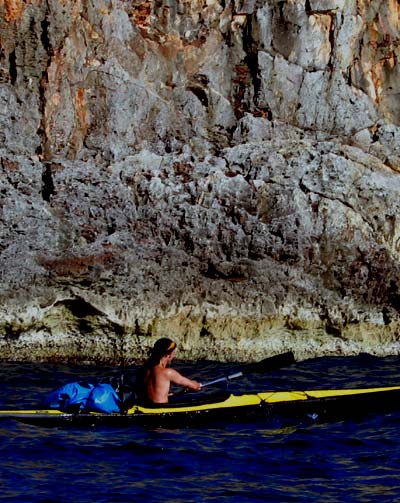
But we were in high spirits: we were at sea, and although were weren’t quite island-hopping like on our legendary Greek Expedition, still we had that uniquely folding experience of being self-contained and mobile.
Any form of transportation that avoids the necessity of a return to your starting point has the possibility of being a viable and efficient form of transportation. If it makes for interesting sport, too, it is raised in status to being thoroughly cool. Anyone that has had to use two cars to have one waiting downriver, or who has had to paddle back along the same route they’d gone out on, all to return the boat to a rental place with silly hours, they’ll know what I mean.
Cars are great such transport, when you have your own, but are frustratingly limiting on the water. I always thought multi-pitch, traditional gear climbing to be a quite impressive self contained transport... not the "traditional" with the hammers and pitons, but the modern "trad" climbing with removable protection like cams and friends. Then there’s descending cliffs or canyons without leaving any gear behind: e.g. absailing (rappelling) down one rope and then pulling on a second rope which unties the clever knot which was firmly keeping the first rope around a tree. Both ropes come tumbling neatly down when you yank on the second.
And then there’s folding kayaks that fit into a backpack. We had further fantasized about folding bicycles and folding bicycle carts, so that we could bike the portages and forays inland... But in Cuba I am thankful we were not so independent: our constant and necessary interaction with Cubans gave our days there a delightful and rich flavour.
That day at sea was the most savoury yet. There were at least two more breaks in the cliffs featuring beautiful coves with little isolated beaches before we saw, further on, a few small sailboats returning to what was evidently another inlet. Our reckonings and tired limbs conspired to reason that it must be Guajimoco. We pressed on as the sun sagged.
We finally arrived and entered. It was an absolutely perfect natural harbour for small boats, and beautiful. A long narrow entry with cliffs on either side opened up into a shallow lagoon. The left-side cliffs on the way in, and half of one side of the lagoon, were lined with little cottages, all of the same construction but painted in different pastel colours. It was calm, the sun’s light was late and golden, and there were very few people about. We grinned at each other: we couldn’t believe our eyes! We couldn’t have dreamt up a more perfect locale to end the day. There would be safe harbour, comfort, and hot food. At the same time, I remember feeling we thoroughly deserved some kind of reward for all our indomitable efforts.
There were a few people along one edge of the lagoon, looking at us in wonderment, and we paddled over to them, impatient and intent on finding out if there was actually any accommodation there.
The first and second members of the cast to greet us were clearly divers, and, judging by their gait and attire, they were guides and instructors, too. Muscular, long hair, wrap-around sunglasses, and all smiles. They greeted us and confirmed that it was indeed Guajimoco, and asked where the heck we’d come from in our queer crafts.
Jay and I answered with pride and probably in unison: "Rancho Luna!" - words that I can never help but utter with a slight drawl, and of course with fondness. And the Divemasters of Guajimoco gave us just the very words I never knew I always wanted to hear: "Rancho Luna? You guys are crazy!"
We grinned further, even more broadly, and one of them went on: "Wow, no one’s ever come into this place, from another place, in a kayak!"
Music to our ears. These guys knew how to make friends! Other men were there, too: at least one guy who looked like staff, and a couple of guys who had different security-type outfits.
Soon we found out that it was some sort of resort, and that all of the dozens of bungalows were full that night. Full! What about our cosmic reward? But they were not full the next night, which was interesting. The problem was that the little nearby village had no hotels, no casas, and no restaurants. Playa Ingles was considerably farther, and the sun was grabbing its coat and hat to go out. Shangri La, but it’s full.
However, there was some hope. There apparently might be a way to wangle something with the security guards. They had a dormitory, and if we slipped them twenty convertibles they’d let us sleep in a couple of the bunks, on the condition that we were out of their beds at seven a.m. Pretty unfavourable terms for us, but they had us by the talegas and everybody knew it.
We agreed, of course, but there was some other sort of complication that we had to wait for. One of the "security" guards was holding things up trying to get a hold of his boss. It turned out that this guy was from el Ministerio del Interior and he didn’t know how to cope with our extraño, extranjero, and altogether unexpected arrival. He was stationed there year ‘round waiting for stuff like us to happen. Finally, we happened, and he didn’t know what to do. I find this sort of pathetic. Maybe he was doing exactly what he was supposed to do, but I was, and remain, determined not to like this guy.
I went to grab us a couple of beers at the resort to assist our wait for the word on his phone call.
At one point, he was speaking to someone on the reception phone, and he called over to us to find out our nationalities. We told him, awaiting further questions, but none came. Then he was off the phone and informing us we had to stay put (where would we go?) until his boss came to see us.
This made us a little worried, and we began to wonder why they had only wanted to know our nationalities... Was there some deeper significance to this question? The very first fear that jumped into our hungry paranoia was that this rat’s jefe had some awareness of the Cienfuegos fiasco. In fact, he must, for otherwise why would he be disturbing his important affairs to come down and bother with little old us?
He took a while, and I’d gone off to unload the ‘yaks - it was getting dark and there seemed little doubt that one way or another we were sticking around there. I can reconstruct what happened in the next scene based on Jay’s testimony:
A jeep screeched in and two men in military garb jumped out. A few words with el rata directed them to Jay who stood smiling, beer in hand, and with a hearty "Buenas Tardes!"
One man, who reeked of authority, seemed to be fuming, and the very first sentiment from his lips was something along the lines of "You knew you were not authorized to be out there!"
He was none other than the Captain of the Port of Cienfuegos, in the flesh, and a few days ago, when asked by our optimistic and friendly captor at the Cienfeugos Bay Frontera, he had explicitly said we were not to get back in the sea without permission.
At that point Jay pulled a "No hablo Español." He, and the Captain, and his entourage, now four strong, all came to where I was unloading the kayaks.
It took us a while to calm him down. But who’s heart wouldn’t soften faced with Jay’s and my angelic countenances beseeching with such earnestness?
I don’t think he was sure himself how to deal with us, and when earnest beseeches failed, we tried being grovellingly submissive, and that did the trick. He seemed to decide on just trying to frighten us, which would be less work for everyone. Which is to say he didn’t fine us US$3,000 each, but he expressly forbade us to ever reassemble our boats anywhere in Cuba. He told his resident minion, el rata, to make sure and escort us to the road when we left the resort.
We were free, but utterly stricken by this turn of events, and suffice to say we were none too happy with el rata’s role in our downfall. I remember that that night he had the nerve to ask us to buy him several rounds of beer when he got off work. That was while we were sitting around, disconsolately drinking and watching a twenty person tour of French being taught to salsa dance in the resort bar. It was a new low for us, and for the Expedition.
The next morning the new day gave us new courage. We had decided not to obey the Captain’s injunction. After all, we still had twelve days left in Cuba, and we weren’t going to spend them merely sitting on some beach getting drunk! We had to attack the problem from a different angle. Perhaps we should try and get permission from the authorities. Obviously we’d burned one bridge, but we convinced ourselves that it was unlikely that this Captain had any influence outside of the state of Cienfuegos. All we had to do was get out of range.
But we didn’t know when we’d next be able to paddle, so we had to spend the morning trying to dry our boats. They were still quite wet. For some reason, in spite of the intense sun, it took several hours before we felt we could repack them. The resort was probably anxious to be rid of us by then: it was becoming clear that we weren’t going to stay there. The food had been awful, and anyway why would we stay where we couldn’t use our boats?
When the time came, el rata led us to the road. I remember with what amazement I received his demand for a tip, which he said was "customary." I laughed in his idiotic face.
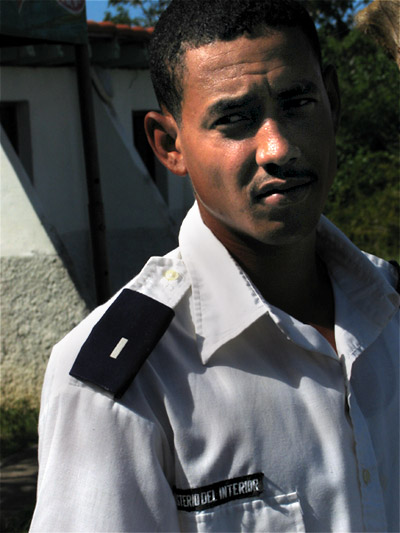
We commenced hitchhiking towards La Boca, a village on the water just near Trinidad, and, most importantly, in the next state. There were several enticing looking rivers in the area, and, as we drove along the coastal road, we observed with mischievous delight that there was a gorgeous river, which meandered inland into lush hills, that demarked the Cienfuegos state border. As long as we stuck to the east side of that river, we were out of their jurisdiction... right?
Tuesday, November 09, 2004
Part 7 - Gibara to Rancho Luna, and Trouble with El Ministerio del Interior (Part 1)
We were only just beginning to figure out how to do some things in Cuba. The process of discovery and learning is what fuels the traveller, but some places on earth are so different that it can take years or never to begin to crack or comprehend the cultural enigmas. For your humble narrator, Cuba is a country that continually amazes, blending familiarity with strangeness in a way that always makes one want to explore a little more. It’s not for the beauty of the countryside, the coasts, rivers, nor the beaches, but for the culture, the people, and the way everything functions (or not) there.
Fisherman Buddy found us our driver who took us to the Holguin Bus Terminal for ten bucks. We had a couple of hours to kill in Holguin before our tourist bus (Viazul) arrived, and so I poked around the area of the station to find food, and maybe a car that could take us to Cienfuegos so we wouldn’t have to fraternize with tourists.
There wasn’t much going in the coche particular department, but one taxi quoted something over $200. Taxis! During our whole trip, we only took one taxi in Cuba, and that was from the airport, on arrival, when we hadn’t known better. I remember visiting Brooklyn last year and it was similar: you called a car, never a cab.
Anyway, the bus was right on time and very efficient. Apparently the Viazul company has that reputation. Certainly, nothing else in Cuba was ever very punctual. This one had probably already come all the way from Santiago.
The fare was $25 each, but we had to pay a bit extra for our Pro Packs, which had put us overweight. Between the two of us it seemed a lot of money in Cuba, but after all it was a nine hour journey to Santa Clara. Theoretically it could also have been very comfortable, since there were not a lot of people on the bus, but as it was the seats they had installed seemed to want to eject their occupants, which is to say, us. Anyway, for a while there was an unidentifed but engaging American action movie, in the heist genre, to entertain us. As an avid video-viewer, it was comforting to watch a screen again. The movie was hardly spoiled by the sorry sound which made speech unintelligible, and the poor picture which made image details indiscernable and the Spanish subtitles unreadable.
I also managed to while away at least an hour and a half doing my Pimsleur method "Essential Spanish" lessons, at least twenty-five hours of which I’d loaded onto my mp3 player. I sat there, staring out the window, muttering phrases back at my two patient, agreeable latin friends. Sure, they were deaf, and pre-recorded, but I can say that for anyone trying to learn Spanish (or any other language) I heartily recommend Dr. Pimsleur’s clever and effective method, and Simon and Schuster have it in audiobook form for quite a few languages.
All the way to Santa Clara, and we only had one 30 minute breakdown! It was a very successful trip and I was very impressed with Viazul. But, in the end, it had been too sterile, and we never took another tourist bus again.
Admittedly, it ended up working to our benefit. We arrived in Santa Clara at 10 pm, not even dimly aware that the bus terminal was as far out from the centre of the city as it was. We had no where to stay and no leads, but it turned out that a pair of middle-aged Belgians that we’d met on the bus had made arrangements, and their hosts were waiting for them at the terminal, and it turned out there was an extra room! So, we all piled into a carriage and were drawn into town equestrianally ($5).
To another abundantly hospitable casa. On arrival, the hostess made me and Jay a hardy and nourishing meal even though it was nearly midnight. The next morning, she spent at least an hour on the phone trying to get us either or both of a car to Cienfuegos and a casa once there.
We only really cared about the car, but by the time we’d figured out that it wasn’t going to happen through her, we’d missed both the daily buses: we’d naïvely assumed that because of the proximity and supposed popularity of Cienfuegos it would be commutable throughout the day.
So, we hoisted our boats onto our backs, bade our hosts farewell, and headed the two blocks to the town centre to try and find someone with a car. We didn’t see any other alternative.
Now, in hindsight, I see that perhaps we would have fared better by somehow making our way to the outskirts of town, along the road that went towards Cienfuegos, and hitchhiked from there. Or else we could’ve gone back to the bus station and loitered, since it turns out that often that is the most common place for cars to troll for passengers.
The "rules" for hiring private cars change drastically depending on the danger to the driver of getting the famous 1500 peso fine (that’s pesos cubanos, of course, so around $60). In Santa Clara, it soon became evident that that danger was great: there were people with cars all around the centre area, but for the longest time not a single one would bite. It wasn’t even as if they would offer a high price: simply no one wanted to do it. The tourist taxis wanted fifty or sixty bucks. Ha! It’s only a 67 kilometre drive!
While we took turns trying to find a ride, the other would wait with the bags in the immense plaze in the centre of town, watching stuff happen. And in this way, in turns, we became enamoured with Santa Clara. Here was an inland city in Cuba that seemed to have virtually no tourists, lots of young people, and a happening vibrance.
Eventually I found a man who was considering giving us our ride. He was an older guy, and a pained and worried look overcame his face as he made his decision. His buddies all seemed to be saying it was his funeral, but that if was going to do it, take this or that route and be careful, and so on. He wouldn’t go lower than thirty, but by that point we were realizing that it was him or nothing until the next bus the next day.
So, this guy, like the guy who was the driver for our first private car ride (Bayamo to Antilla), figured a good starting strategy for not getting stopped by the cops was to have his wife ride shotgun. As we drove through town, his stress was palpable. Every turn of a corner was made slowly, and with neck craned to see what may lay ahead.
But as soon as we left the city limits, there seemed to be much less to worry about. There would probably be no police checks along that highway. We agreed that, if stopped, we’d been hitchhiking and they’d picked us up. Once again, if we could convince the police that no money had changed hands, there was no crime. Once again, it didn’t seem too plausible to me: why would they pick up hitchhikers and take that risk unless money was changing hands? Anyway, I didn’t argue.
It turned out to be the best ride of our trip. Not only had this couple been in the Revolution, but they’d fought in Che’s batallion. And check this: they’d met each other while holed up in the Sierra Maestre, had fallen in love, and had sworn to marry each other if and when the Revolution was won. The historians amongst you will remember that that is exactly what happened.
This guy had gone on to fight with the Cuban army for his entire life, travelling all over the world on service. They both had a tremendous belief and lifelong dedication to the Revolution, and to Che. I found it pleasingly ironic watching patriots perform police evasions, and I believe that the paradox is understandable given the downtrodden state of life in Cuba. Impossible to hold it against this wonderful and passionate couple, to be sure!
Cuba seems to have an immense black market trade in all commodities, from rice to gasoline. Hence all the police everywhere, stopping cars regularly. This is why it isn’t always easy to get a private car, and why the Cubans we tried to help help us were not safe from being fined until they got us out of the car unseen. I’m profoundly glad that no one ever got nailed on our account, at least so far as we know.
At one point, the woman asked us if we’d gone to visit Che’s mausoleum, one of the things Santa Clara is famous for. We flusteredly tried to explain that we’d only been passing through and really we just wanted to paddle our boats somewhere, and... but it was too late for all that. The couple sort of glanced at each other and then stared off at the road ahead, silent and stone faced. Clearly this was a major offense.
We recovered by saying that we were surely coming back through, and would just love it if they would join us in a trip to all the city’s mausoleums and monuments, or at least for coffee. At this, they reanimated and with much enthusiasm they said they had friends with a great casa close to where they lived, and here was their phone number, and when we came back through we’d all get together and have coffee and see the monuments. Great! Just imagine checking out their old photos and army equipment and stuff...
And so by the time we got to Cienfuegos, whereas at first they’d wanted to deliver us as shallowly into town as possible and get the hell out, now we were all good friends and they helped us check out a couple of different casas. They wanted very much to make sure that we found something to our satisfaction. We parted with big hugs, and kisses on the cheeks.
On the way up the street we’d been driving we saw a guy standing outside a door in silk leopard-print boxers and a shirt. He was potbellied, mustached, and carried a drink in his hand. A few minutes later, after seeing another place and finding it full, we were directed back to a certain address, and sure enough it was the casa belonging to leopard skin boxers guy. His name is Sissi (!) and his wife’s name is Marta, and they have a stylin’ and swingin’ pad in Cienfuegos, telefono 207991. When you get there, check out the photograph, near the bar area of the living room, of him with his shirt off, donning a big sombrero, and doing air guitar with a beer in his hand. Turned out he’s a doctor, too.
It was $35 total for both of us to stay there, including dinner and breakfast.
We checked out Cienfuegos but we don’t have much to report. It’s got one intensely prettified and touristed street, and a malecon area where reputedly there’s a night life. There are some beautiful colonial buildings, blah, blah, blah. Mostly we wanted to find out whence we would launch in the morning.
Cienfuegos has that one long finger-like peninsula, where the malecon is, and we picked a spot down that way where it seemed we would’t attract much attention, and where there was a nice grassy area next to a miniscule beach offering a sheltered and easy entry to the bay.
And so the next morning there we were, trying to pack our boats with all of our belongings for the very first time. There had been talk of attempting to do a test pack in Toronto before leaving, but it had never happened. Especially doubtful was just how Jay’s guitar would fit. It’s a mini-guitar, well suited for backpacking, but the Cooper kayak is skinny and all the longerons make it even trickier to pack.
With the Cooper, the frame is completely assembled before pulling the skin over it. So, Jay got his guitar in his Pro Pack dry bag and fit that into his frame before inserting the frame into the skin. That seemed to work well, but we had misgivings about how well this method would work on a day to day basis: we hoped to be able to just leave them assembled for at least a few days while we made our way down the coast. It’s neat the way you can assemble and disassemble a folding kayak, but between drying and going through the procedure twice a day, it can get old.
There turned out to be a whole stroke of swimmers there, as well as some other fishermen types, and so we ended up with a bit of an audience gawking at our assembly procedure. They commented amongst themselves quite heavily, but didn’t bug us until finally one of us said something in Spanish, at which point the questions and advice began to flow.
When I told the fishermen about our plan to kayak all the way to the Trinidad area, they (like others before them) thought we were crazy. They said it was "open sea" and that while we’d be fine to Rancho Luna, beyond there it would be lunacy. I didn’t tell Jay, but I stored the information. I wasn’t sure whether to believe them, since they hadn’t really displayed any knowledge of or experience with sea kayaks. And anyway, weren’t we on the lee side of Cuba? And wasn’t there supposed to be a protecting coral reef all along that way?
It didn’t matter. One problem at a time. We were tired of being told we couldn’t do things! It was entertaining for a while, sure... but morale was going to be seriously affected if we didn’t soon spend some contiguous quality time on the water. Immediately upon being packed, we set off.
The wind was already high, and we had to paddle harder than ever: our boats were fully loaded and the bay was poorly sheltered. Also, before long we realized we didn’t know which way to paddle. Looking at the horizon, we could not make out where the mouth of the bay would be. The road atlas was little help, since we couldn’t match up what we could see with what was indicated, and anyway we’d lost much faith in the accuracy of that map ever since we’d found that large lake missing from it along the Rio Cauto.
We must have gone at about right angles to the direction we should have gone, and ended up moving east and then southeast, staying parallel to the shore. South, in a straight line, would have got us directly to the mouth, and within six or seven kilometres. Next time, maybe I’ll bring a compass. Nautical charts wouldn’t hurt either, but that requires actually knowing where one is going.
We were having a hell of a time getting our boats to go straight, and to top it off Jay was concerned that there was a leak in his boat because water was accumulating below his soggy seat. We hoped it was just the water splashing into the cockpits from the waves – as usual we hadn’t put our sprayskirts on and were too busy to rectify.
The shore and scenery were unremarkable, and after an exhausting battle we ended up over in the south-east part of the bay. We decided to head what we hoped was west, around the south side of an island we could see, one that we thought we’d identified on our map, and that maybe there we could rest our arms a little without constant relocation by the wind.
We hadn’t hoped for much from that island: it appeared entirely overrun by mangroves, but when we rounded it we found an old abandoned port and a small sheltered beach. Even more interesting, the port was populated by half-sunk and rusting hulks. We stopped to rest, eat, and bask in our success. We were in no huge rush, since through Sissi and Marta we’d already booked a casa in Rancho Luna where someone was supposed to be awaiting us. We would not have to run around looking for accomodation that day, and so there was no particular need to get there much before sunset.

| 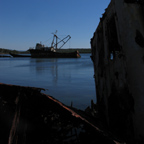
|
We reckoned that we were very probably on Cayo Ocampo, and that it would be difficult for us to miss the mouth if we just set out west parallel to the shore. We picked a point and tried to bee-line it there, but damned if we didn’t miss having rudders on our boats! There was a repulsive amount of pull to the right, and I had to point my bow all the way towards the south if I wanted to eventually form a nice big arc where I ended up pointing west-ish. Inefficient, but far better to paddle with both arms at full force than constantly compensating using only one.
It was a great battle, but we ached for some shelter so we could rest, at least to sit peacefully in the water if we couldn’t land. We finally came round the point marking the beginning of the mouth’s channel. In there, the wind was right at our backs. This may sound good, and it’s better than the reverse, but it doesn’t mean less work. You still have to paddle your arse off to stay in control.
Ahead we couldn’t help but spot the Hotel Pascaballo, which had an inviting wharf complete with bar. We swung by there to investigate it as a break spot, but the water was too rough to leave our boats merely tied up, and the wharf’s deck was too high up for us to get them out of the water. A little exasperated and even more exhausted, we set back out. Surely by leaving the bay we’d finally be shielded from the wind’s attack.
And as we broke out from the mouth we could see, off to the left, to the east, the smooth surface of easy paddlin’ waters. The Caribbean at last!
Just then a large boat, a passenger ferry by the looks of it, appeared off to our starboard side. There were a half dozen men along its railing calling out and waving their arms. I gave them a jovial salutation and made to head off into the sun.
But they were adamantly yelling at us. We feared the worst and briefly discussed whether we should just ignore them. We decided, wisely I think, to paddle over and see what they wanted.
Well, they wanted nothing short of our absolute downfall! There they were, a few of them in military uniform, all chorusing that we were not to paddle any further, and that we had to turn around and return to the bay.
I tried to explain that it was impossible, the wind was far too strong for us to return to the bay, and that lo! Over there where we were going the water was a calm as nirvana!
No, no, that wasn’t the way it was going to be for we intrepids. The looks on their faces did not speak of friendly concern: we were contravening their system and everything their authority stood for. The ferry was not on its way somewhere, either: it was specifically after little old us. We did not have permission to leave the bay and if we couldn’t return the way we’d come, we had to land at that hotel’s pier.
Well, we tried to explain that we couldn’t land there because it was too high, but this didn’t seem to sway them out of their resolve to quash our haphazard plans.
With heavy hearts we turned around and forced our way into the wind and back to that wharf. Once again, we couldn’t really work out a good way to get our boats out of the water there, and the shore itself was lined with brutally jagged rocks. It would not have been a huge problem if there hadn’t been so much angry chop, but, well, there was so much angry chop!
A bit further up the bay’s gullet, on the same side as the hotel, was a rickety old dock, quite low, which if it would hold our weight would be suitable for removing ourselves from the water. We spotted the fisherman who belonged to it and requested his okay for us to disembark there. He didn’t seem to mind or care, waved us in, and then promptly disappeared into his hovel.
We hauled ourselves out of our cockpits and onto the dock. We had to use our dangling feet to secure the kayaks from getting blown off to sea, and, when they swayed the other way, to keep them from getting impaled by the numerous rusty iron rods that projected from under the dock. We sat there thus, catching our breath and trying to think how best to withdraw our boats from the water.
Meanwhile, the ferry, which had retreated after we’d reversed direction, had changed its mind about leaving us alone and was heading straight for us again. I still don’t fully understand why. Jay thought it might be because we’d pulled up to an ordinary citizen’s property and they didn’t go for that: they’d wanted us to go to the hotel’s wharf.
In any case, clearly they’d thought better about leaving us to our own devices, because there they were pulling right up to the rocks not thirty feet away from us. Five or six men jumped to shore and marched over to where we sat rolling our eyes.
They wanted to take us and our ‘yaks onto their boat, although it was unclear why. We thought that maybe they wanted to take us to the hotel’s dock. O silly Canadian optimists!
We protested about them manhandling our unusual sea vessels. I had a fear of bending the longerons out of shape if the boats were lifted by the ends while they were fully weighted down by our belongings. I still don’t know how well the Coopers handle this, although it is now certain that some of the cross-bar connections pop out when the boats are portaged with gear inside. In fact, some of these connections can pop out while paddling in medium waves. To be fair, though, I’ve heard that folding kayaks are designed to have a certain degree of redundancy, so that seaworthiness isn’t impaired by one or two failures. We both agree that this problem would likely be solved by using more of the velcro ties that Folbot already supplies with the Cooper for securing many of those connections.
The men trying to get our boats out of the water were surprisingly cool about our prissy resistance to their desires. I was saying I wanted to unpack some of the heavier stuff first, and whining about how they had to be careful and so on. In the end it was far too much trouble, and too unnerving, to explain, try to unpack the boat while it was still in the water, and make them wait, so we just lifted them out as was. We did our best to help support the boat from the middle and make sure they didn’t drag the hull or put them down on anything sharp.
Well, the ferry didn’t go to the hotel’s wharf. We headed straight across the mouth of the bay to a big cement structure on the other side. We’d noticed it before but hadn’t really thought too much about it, other than being warmed by the huge letters written across it reading Bienvenidos a la Cuba Socialista.
Now we know quite well that it was la Frontera outpost where el Ministerio del Interior monitors the comings and goings of all crafts. They have huge military searchlights and large, clunky, mounted binoculars. There were numerous armed soldiers populating the place. All in all, it didn’t seem like too congenial a situation.
Our kayaks were carried onto the Frontera’s quay, most of the men disembarked, and their boat left. Actually, we soon discovered that that base didn’t have their own boat, and that the ferry was really just what it looked like: it was the passenger ferry that plied the mouth of the bay. They’d commandeered it to apprehend us! What an honour!
Then the officer in charge showed up. He looked us up and down, glanced at our boats, demanded our passports, and left. At this point our level of nervousness increased ever so noticeably. No traveller likes to be separated from their passport, least of all when they might be in some degree of trouble.
We stood around speculating as to what degree it might be, but before long the officer returned, passports in hand. He was smiling, and for a glowing moment we figured that in a few minutes we’d be back in the water and paddling off, victorious.
No, though, he was smiling because he was a good-natured dude. But he had no good-natured news for us. It was more along the lines of: okay, you guys aren’t wanted by the law, and your visas are in order, but you’re walking from here, not paddling, so fold up and pack off.
We’d suspected as much, and had already begun to unload, and so again began the tear-down. While busying ourselves with this, we gently questioned the officer about what we could or could not do in Cuba. This is always a dangerous line: we only wanted to hear about what we could do. To hear that we could not do something would mean we could no longer truthfully claim ignorance about that thing.
He thought that rivers and bays were no problem and that we should be able to paddle to our hearts’ content in those... But then, I thought, of course that would be the perspective of someone working the country’s borders. Rivers and bays were someone else’s problem. I cynically feared that good folk like him just like to tell positive news when they think they can get away with it. In any case, up to that point on our trip, in rivers and bays it seemed as if he was right. Or at least that whoever’s problem it was wasn’t concerning themselves much with it.
We were very curious to know just how one goes about getting authorization to paddle outside the bay. We’d heard that foreign sailboats and yachts can do it, so why not us?
Well, he seemed to think it was the easiest thing in the world! You just go to the local marina international and request permission. He said they’d surely grant it, and then you just have to re-apply at every new port you get to. They just want to be aware of who is coming and going. They then notify any Frontera lookouts who will then happily let us go our way.
That sounded easy, but dubiously. But he was so keen on it that we slowed down our disassembly and asked him, since he was being so friendly and positive, if he wouldn’t mind contacting the marina international in Cienfuegos on our behalf. After all, he was a man of authority. Plus, he’d seen us, our passports, and our boats. He was in a perfect position to help us out.
He thought that sounded reasonable, and he went off to try it. We were so hopeful we stopped our packing. We stood there looking out at the Caribbean wistfully. Since we weren’t going to get in any serious trouble like being fined, jailed, or having our boats impounded, we were really starting to appreciate the travel aesthetic of being picked up by the Ministry of the Interior in a commandeered ferry. It was far more interesting than having glided uneventfully out of the bay, which is probably what would have happened in most other countries.
Alas, he returned shaking his head, shrugging, with arms extended in the universal gesture of helplessness. The Captain of the Port in Cienfuegos had said that we had to go to his office in person.
We finished packing and walked out of the gates of the Frontera base. We had to run to catch the very same passenger ferry that was now being used for its mundane purpose. Then, as a further insult, we had to pay to use it! This we did good-humouredly, but when the ferry flunky pointed at our kayak bags and then at the obscure listing for refrigerators in the posted fares, we had to draw the line. Forget it, buddy.
We found ourselves on the other side of the mouth of the bay, yet again, and walking up the embankment to where there was supposed to be a local bus to Rancho Luna and to Cienfuegos. Should we go back to Cienfuegos, find a place to stay, and apply to the Captain of the Port in the morning? Hell no! We arrived in Rancho Luna as the sun was setting.
It’s a small place, and finding la Casa Teresita was as easy as asking the second person we saw. She was waiting for us, and it wasn’t long before she was cooking up a tasty storm. She was an outstanding chef! My mouth waters thinking about her yuca garnished with fried garlic.
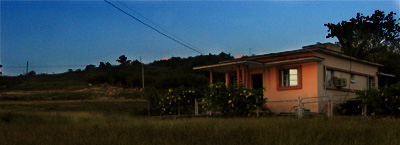
We had to rethink things. We were now a little more informed, and we realized that it behooved us to obtain permission before proceeding along the coast.
But really we were only a little less ignorant. It would turn out that there was no marina international in Rancho Luna. We also couldn’t know that although we'd resolved not to retrace our steps and return to Cienfuegos, we hadn’t finished with our dealings with the Captain of the Port in Cienfuegos. He who would later learn to curse our very existences...
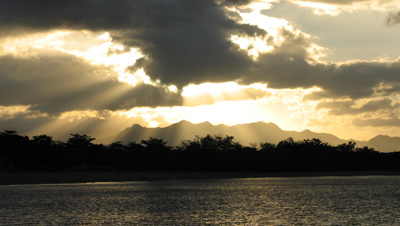
Sunday, November 07, 2004
Part 6 - Glorious Gibara Rivers
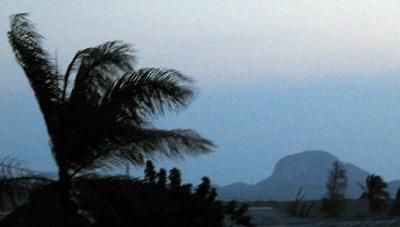
That river, the first one round the bay from the colonial town of Gibara, had left an enticing flavour in our mouths. Except for the new concern for our boats’ hides, kayaking in Cuba had been a clamouring success. We hadn’t really known what to expect, anyway, so everything after the mangroves had filled us with joy. I can heartily recommend the rivers in that particular bay for great kayaking. What we didn’t know (because we hadn’t really checked) was that Cuba was undergoing “the worst drought Cuba has known in the last 75 years” and so, well, the rivers were a bit lower than they should be, to say the least. I’m sure that after a few months of healthy droughtlessness these and many other rivers would be eminently explorable, and for a good deal further than we managed.
.jpg)
|
| Photo by Jay Field |
We waited a day before we went out again. My intense throat infection had passed, but it was Jay’s turn to feel ill. We whiled away our time taking pictures around town and visiting Gibara’s interesting and bizarre Natural History museum.
-T.jpg) | 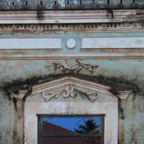
|
This museum was founded on a particularly passionate scientist/taxidermist’s extensive collection of specimens. Included in these was a sub-collection called Deformación . This exhibit was over in a small, dimly lit corner, and it seemed deliberately avoided by the otherwise talkative and generally charming guide who attached herself to us. There was one display there containing the foetuses of animals too deformido to live. Twin pigs sharing a single head, a pig with a dog’s head, and other gruesome peculiarities. I daren’t show these on the internet (but I can send them to you as prints for only five Pesos Convertibles plus shipping. Just kidding.) These are some of the non-deformed creatures he had pickled:
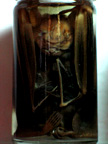
| 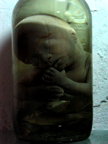
| 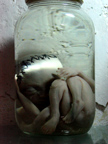
|
The day after that we were intent on the second river, but Fisherman Buddy couldn’t get the keys to the shed where his friend’s canoe was stored. Something about visiting a sick cousin in Holguin. In the end, she didn’t even die or anything, so it was really quite a shame he couldn’t come with us. At least we got to show him how the boats were constructed, and I let him take mine for a little spin.
.jpg)
|
| Photo by Jay Field |
It was a bit further of a paddle to the second river, but it was not nearly as windy as when we’d gone to the first. It felt fantastic to be able to let it all hang out and paddle like madly mad mariners out on the bay, able for a little while to forget the threat of rocks.
We reached the wide mouth of the river all too soon. The banks were lined, like at the beginning of the other, with mangroves. It was very different, though, for its width: this river began wide and straight and long, so you could really see just how far you were going to have to paddle before it might start to get interesting.
Happily, it turned out to be just as rewarding as the first, missing only that big advantage that the first had which was, of course, that it was the first.
.jpg)
|
| Photo by Jay Field |
The kayaks performed beautifully. However, we were more aware of the rocks, which slightly degraded our overall pleasure level. And in spite of this awareness, we still got some scratches and tiny gashes, much to our irritation. We had yet to learn to accept these and the subsequent patchings as all part of the package.
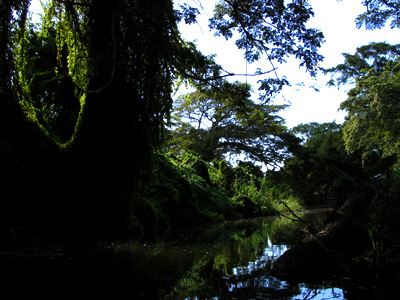
It was getting easier to deal with the Coopers. We became better at assembling them, and better still at disassembling. (It’s all in the packing technique.) The one thing that turns out to be the slowest step in dealing with the boats is drying. I’d already started to discover the hardship of this with the Folbot Yukon I’d used so much in August.
The problem is that you shouldn’t pack the boat wet if it might stay packed for more than a day or so, especially in hot climate. If you do, you are reprimanded by having a boat inhabited by the mouldy smells of decay. Kayuk.
Most of the time, with direct, warm sunlight and a light breeze, you can dry the boat satisfactorily in around an hour. You’ll want to take a few of the parts out later to stand and dry out, like the longerons that have on them somewhere little bits of the softer part of the velcro strips. Also the seat and the life jacket. But the key is to get the skin dry, because it’s not always easy to find a place to stretch it out later.
I think that a really absorbant rag, or a big old chamois, is one of the most important items that ought to be brought on a folding kayak voyage. It speeds up drying tremendously, which usually ends up needing to be done during those precious sunlight hours.
High humidity slows down the drying process to a snail’s pace. Even in direct sunlight, it can take two hours or more to dry a skin out. You need a nice, dry wind to help you out, and sometimes this isn’t available.
It ended up being reasonably fast drying our boats that day. We’d gone as far as we could up both branches of the second river - even past the road on the southwesterly branch. We turned around, and could have stopped at the road, dried up, packed up, and hitched a ride with one of the many horse and carriages that were going by, but instead we decided to wind our way back to the bay.
It was a hard paddle: the closer we got to the open water, the stronger the headwind. When we finally arrived at the bay, the wind was raging in noisily from the north, causing whitecaps and kicking up sand from the beach at the delta- like mouth.
We sagely decided to not try and paddle all the way back to the town beach we’d started out at in the morning, and we disassembled and dried in the high winds on the beach at the river mouth. We were exhausted, especially from the paddle back, and we still had about two miles to walk to Gibara, along the path we hoped we’d find along the shore, with our boats on our backs.
We set out on foot as the sun was setting, picking our way over all the driftwood along the narrow strip of beach. It felt good to use different muscles, and the exhiliration of the day made the weight of the Pro Packs seem less.
.jpg)
|
| Photo by Jay Field |
We finally arrived at the edge of the first river. To cross it we would either have to wade, or paddle - but there was no chance we were going to assemble, disassemble, and dry again! - or use the old and rickety suspension bridge. Of course we opted for the latter.
The pieces of wood were rotted, some broken, some missing, and we wondered if the extra weight of our boats would be just a little more than some of them could handle. Good thing there were two solid-looking cables running under them: I kept my feet right above the cables, and my eyes glued downwards. I thought about food.
For that night, Fisherman Buddy had hooked us up with another casa for dinner. It’s not clear whether the place was purely for dining or what, but I didn’t see the “state approved for foreigners” sign anywhere outside. Clearly they specialized in dining, as there was a large-ish gathering of Cubans being served when we arrived, in a room roofed by traditional thatching. We opted for another room, which was just off the kitchen.
We had wanted to go there ostensibly to distribute our patronage a little, but a big draw was that Fisherman Buddy had promised us that they regularly have turtle on the menu. An entire all-you-can-eat feast, including the coffee, was five bucks.
It’s getting almost tiresome to note that the family that ran the place was outlandishly friendly and warm, and that we just wanted to be adopted by the mother so she could feed us the rest of our lives. On the other hand, the turtle, although marinated, was sliced thin and slightly overcooked. It was a bit tough. It tasted like rich beef, which was nice, but it wasn’t as good as other strangely beef-like meats like, say, ostrich.
Turtle meat is illegal in Cuba. Yeah, I know you’re not supposed to eat endangered animals and all that, but are all turtle species on the brink? Anyway, hell, you have to try these things, I say. I’d like to try turtle one more time someday, but in the form of the soup that folks are always prattling on about. I’ll bet it’s incredible.
We stuffed ourselves, and we even had a desert, possibly one of my favourite deserts on earth, of sweetened guava sauce on mild cheese.
We had treated Fisherman Buddy to dining with us for being such a cool guy, and over dinner we tried to extract information from him about where we should go from there to find some real coastal kayaking. The fact was, though, that while he was intimately familiar with the region we were in, he knew next to nothing about anywhere else.
As usual, the only way to find out any real information was to guess and then just go.
To this day, we still don’t know how good the multitude of cayos along the north coast of Cuba would be for kayaking. As far as we can tell, they are uninhabited except for a few that have resorts on them. Casas particulares are not permitted anywhere along them. Veradero, according to our guidebook, seems to have some cheap hotels, but we reckoned that area would be depressingly devoid of real Cuban flavour. Also, virtually all of the cayos were marked on our maps as “mangrove/swamp”, and there didn’t seem to be much chance of doing any multi-day trips without camping most nights on these islands that may be mangrove or may be swamp. Neither sounded too good for the kind of camping we were “prepared” for: we each had a light sleeping bag and a small mosquito net.
There may be potential up there for some great kayaking – I’d love to know what it’s like - but I think one would need to have different equipment, like fishing rods, cooking gear, tents, and gosh, maybe even a two-way VHF marine radio.
It seemed to us, then, looking out over the Atlantic by Gibara, that much of the north coast was off limits simply because of the North Wind so pronouncedly featured by the Cuban winter.
So we pored, pondered, postulated, and eventually proposed that the area on the Caribbean coast between the cities of Cienfuegos and Trinidad looked quite promising. We found a sentence in our guide book that implied that there might be a coral reef all along that stretch. We hoped that this might mean that it was sheltered from any big waves coming in off the Caribbean. We also reasoned that by being on that coast, we should also be sheltered from the North Wind. Lastly, it seemed as if there may be a few beaches and two or three potential legal places to stay along that route.
That evening we began the process of trying to secure un coche particular - an illegal car and driver - to get us to Cienfuegos, half-way across Cuba. This would prove to be impossible in as small a place as Gibara. So we had to start looking into bus transport: our host Nancy checked the Viazul (tourist bus) schedules from Holguin, but (of course) there were no buses going to Cienfuegos. It seemed as if the best bet was the daily bus bound for Havana, and we would get off in Santa Clara and make our way to Cienfuegos from there. There didn’t seem to be any buses to Holguin from Gibara, leaving tourist taxis as the only legal method, which was completely out of the question – they are very expensive. Therefore, we only needed to get a coche as far as Holguin.
This is all to say that transport in Cuba is one of the many very challenging aspects of visiting the country outside the resort spheres. It would take all of one day and more than half the next to go less than six hundred kilometres, and this is heading for a popular tourist destination. Cool!
A rental car would help on a trip like this, I guess, but we were aiming to fulfill the fantasy of moving from place to place without having to loop back. We wanted to get somewhere where we could paddle off with all our gear in our ‘yaks, and never look back. We hoped that starting in Cienfuegos we would achieve this. And besides, relying on private cars was much more interesting: when you’re too independent, you have that much less interaction with your surroundings, and our rides there were some of our best memories. We got to hang out with folks who usually had very little to do with foreigners, and we had them all to ourselves for the duration of the ride. To top it off, averaged out it is more or as economical compared to almost any other form of transport.
So, the next morning we were leaving el Oriente and off towards the Caribbean. We were unsure how far we would make it, but we had our boats and we had a mission.
Little did we know what trouble there was in store for us from the Cuba’s “dreaded” Ministerio del Interior...
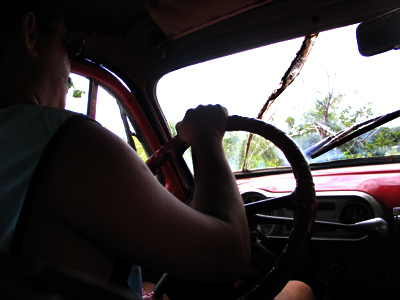
Friday, November 05, 2004
Part 5 - Gibara - On the Water at Last
At last, a new car pulled into Antilla. It had been my turn venturing out from the hotel reception where we had encamped ourselves. I watched the brand new red VW Golf anxiously as one of the men I’d approached about a ride earlier walked up to its window. I was hopeful that they were discussing the problem of the two foolish foreigners, but acutely aware that sometimes not everyone and everything on earth revolves around my life. I was already making excuses for him: why would someone who could afford such a car want to drive us around? There are precious few new cars in Cuba.
But hey, they might want to drive us around in order to afford that car, and profit all the more by the gas efficiency of those beautiful babies.
He did a fast U-turn and pulled up to talk business with me. Ten bucks to go to Banes. Oh, the scoundrel! For a 15 kilometre drive! But he knew he had us by the gnarbles. We attempted to be sly: okay, ten to Banes, but what about thirty to go to Gibara?
Gibara was a town name pulled out of a few vague recollections. I remembered reading in the guidebook a few days before that there were casas to stay at there. I hadn’t thought much more about it. Now it was dawning on us how invaluable this information was. Clearly, one could not just show up in any town one chose and expect to be housed. Quite the opposite! The Antilla experience had taught us that we either have to know in advance that there are licenced casas to stay at, or else we have to be mas discreto about our presence, to give potential hosts a chance to not get fined by local authorities. It’s the kind of thing that one could only reasonably expect to get away with in a large town (where there are licenced casas anyway). In a small place, one would have to find someone who knows all the town cops well enough that they could get away with it.
The last possibility would be to find someone who would shelter us for free, in which case they wouldn’t be breaking any laws… The problem with this latter case, I think, is that there is still a chance if the police did find out that they wouldn’t believe that no money had changed hands. So, you see, it’s a gamble whose only gain is the dubious honour of hanging out with us.
There was always the option of just camping out somewhere, with our mosquito nets and sleeping bags. It would have to be well out of sight, though, since we later discovered that any camping outside of campgrounds is illegal in Cuba (for foreigners, anyway.)
So, we’d come all the way out to el Oriente, crocs to the west of us, reportedly huge surf and open sea to the south, and boring and inhospitable coast to the east. Up north there was a resort region, which at least meant a few beaches, but we didn’t want to end up suffering through staying and hanging around resorts.
It looked as if Gibara might have some interesting bits of coast to the east, towards the resorts of Guardalavaca. We reasoned that whereas it might be annoying and depressing to start in a resort area, it might be a good end point. We’d arrive at the supposedly beautiful beaches over there, after two or three days of paddling, relax a little, and get the hell away from there.
Or else to the west of Gibara there was a stretch of coast with a few playas shown on the map, and a highway following the shore. With a road close at hand one could always bail on a failing trip, pack up the boats, and get the hell away from there.
These stories were just rationalizations we clung to so that we didn’t feel we were going someplace in complete blindness, again, which we were.
So, we loaded up our packs in the VW and set off from Antilla at Mach speed. Before long we realized he was taking us up on driving all the way to Gibara. Sweetness. We were falling in love with using private cars to cart us and our boats around. In fact, it turned out this guy’s way of life was to be an unlicenced driver. The term he used was that he worked a la izquierda, meaning, literally, “on the left.” He was certainly an expert helmsman, driving very fast with exquisite control navigating the pot-holed thoroughfares, and he only killed one chicken. (Why was it crossing, anyway?) I wasn’t sure how he got all his fares, given that he lived in Deadendsville, but it seemed as if at least sometimes it had something to do with his brother. His brother was, and perhaps still is, the captain of a big cargo freighter and so, I guess, really got around. I gathered that when people who know his brother visit Cuba, they have our new friend the Professional to chauffeur.
The landscape of el Oriente didn’t fail to impress me again, as it had earlier with our previous ride from Bayamo. It seemed as if everywhere in el Oriente, except around Antilla of course, was extremely beautiful. As we approached the north coast of Cuba, we began to see dramatically protuberant cliffs and pillars jutting out from the earth. They seemed to be milestones on our journey of hope. Now there might be something to inspire us with awe and encourage us to continue as we paddled – this kind of motivational landscape.
We crossed a couple of beautiful rivers and then all of a sudden we were in town and stopping in front of a large colonial building. It seemed random, like our driver had just noticed the licenced casa symbol as he drove by and pulled over instantly.
I walked through the twelve foot high doors, into a long parlour filled with antique furniture, to try and find el dueño. She introduced herself as Nancy, and at first it seemed as if she was going to send us elsewhere, jabbering on about how her only two rooms were reserved. She was already on the phone to call another casa. I’d figured as much: her place was far, far too swank to just fall into our laps like that, so easily. The handsome and airy building went on and on, so that I couldn’t even see its end. The long common rooms were limited above by either thirty foot ceilings or simply open to the sky.
Before she’d finished placing her call, I told her we’d only stay for one night, and then it all seemed okay. She quoted $20, I returned the serve with a smooth $15, and that was okay, too.
Really, I don’t know what she’d been talking about: We ended up staying for days and there was never a problem with some “reservation” showing up.
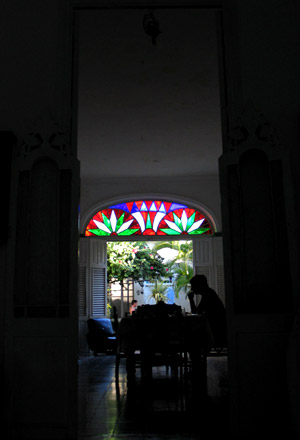
A few minutes later we found ourselves in our room, gaping up at the towering ceiling. The dimension of height outscaled all others: the room itself wasn’t that big… but the roof was tall! A single window was all the way at the top, but the light that came through it reflected off all the faded-white walls of the room to keep it bright from dawn on. A long, long string with a ping pong ball attached to its end hung down from the window’s shutter, but given that we were already habitually up with the sun, and continued to be for our entire stay in Cuba, there was never any reason to shut out the light.
A long, eventful, and moderately stressful day such as that one called for one or three Bucaneros. We couldn’t be bothered to seek out a restaurant, so we consented to the seven dollar cost of a fish dinner. Nancy’s casa had its own chef, which seemed interesting. His name was Alberto.
And ooooh, Alberto! He helped us to see the light about eating at casas. We should have clued in after the illegal place we were lured into off the street in Havana. But Alberto really went beyond what one might expect: he may have been trained by the Cordon Bleu School. That seven bucks got us a multi-course meal prepared with astonishing attention to detail. You know: the vegetables were sculpted to look like flowers. There was a delicious reduction sauce trickled along the edge of the plate. A crème brulée and espresso finished us off.
As it turns out, he’s not Cordon Bleu, but trained in Holguin for the purpose of preparing fine food for tourists in Guardalavaca. The man should’ve been running a restaurant, but instead he served food for the handful of people that pass through Nancy’s two rooms. She was lucky enough to get him because his wife and family were in Gibara and he didn’t want to work so far away from them. (Commuters, eat your hearts out.) Anyway, I’m thinking that he might even do better at Nancy’s, financially as well as familialy, than he would in the kitchen of a resort: he gets to interact directly with guests and develop the relationship just enough so that they become acutely aware of the “tragedy” of someone such as he being “stuck” making so little money. Ah yes, a smart man! We tipped him ten dollars when we finally left, as I believe did the Dutch girls that were staying in the other room when we arrived. So, in a few days, in low season, he’d already taken in more money in tips than his monthly salary. Go Al!
After that life-altering meal we hardly ever ate in a restaurant again.
Over dinner we’d examined our map and discussed all the various possibilities as to how to proceed. Again we had no hard information, and again our decisions felt almost completely random. For inspiration, we walked ourselves and our full bellies down to Gibara’s harbour, just a couple hundred metres away. We wanted to see where we could set up and launch. Also, in case the calmness of the bay was misleading, we were going to head over to the other side of town, where the seawall was, to observe the Atlantic itself. We’d already heard, with great dismay, rumours of colossal and crushing surf.
Near the harbour we ran into a few loitering youths and we all began acquainting ourselves with one another. There was one guy I remember in particular who had a very calm demeanour, and whose Spanish was somehow almost completely understandable to me.
It was one of the first times in my life that I’d had a proper conversation with someone whose first language was Spanish. Most of the time, I have to have every other word repeated or dumbed down to my level, but somehow with this guy there was little or no problem.
It is perhaps ironic, but the only thing coming out of his mouth I never could understand was his name. I asked him to repeat it a few times, but then it was just becoming embarrassing that I couldn’t repeat it back to him, so henceforth, unfortunately, I’ll just have to refer to him as Fisherman Buddy.
It turned out that kayaking had been one of his favourite sports. He never had had one of his own, but he used to take one out every day and train on the rivers off the bay there. Great! A fisherman who knows kayaks from experience! I began to tell him our idea and try to extract from him an expert opinion about it.
Where to begin describing all the numerous problems with our plan? First of all, he said, there was the harbour authorities. Anyone who wanted to leave the bay to go to sea had to have a permit allowing it. This wasn’t just something for foreigners: it was a fact of life for Cubans, too. Though, he added, was not unsurmountable: you just had to evade their notice. To accomplish this, you needed to cut across to the other side of the bay and leave it by the other side of the mouth. They would then probably only see you if they were specifically looking for you with high-powered binoculars.
If caught, you would be turned around and warned. If caught again, you would turned around and fined. After that they’d fine you again, take your boat, and perhaps throw your ass in jail.
This was all fine. Sneaking out of the bay would be fun, but the problem is not left safely behind with Gibara. He said that the north coast of Cuba in that region is replete with stations that monitor the seas for unauthorized boats.
That was not good news. Why on earth are they looking so earnestly? A good question, and there are many hypothetical answers. In this case it is clear they are not there just to watch for folding kayakers. Fisherman Buddy seemed to think that they are looking for freighters straying off the major corridor that goes between Cuba and the States. If a boat enters Cuban waters, then a patrol is sent out to intercept it and search it for illegal cargo. The theory is that Cuba is absolutely against having their territory involved in any of the substantial illicit trade that passes through the area.
Another reason for their vigilance is to prevent Cubans from setting off for America, as they so often do. It is said that there was one tragedy of death in those famously rough waters too many, and so Castro decided to try and curtail these attempted flights. No doubt it was internationally embarrassing to have so many citizens trying to leave. However, apparently, as recently as a decade ago Cuba didn’t pay much attention at all to this, and so previously all concern over these activities had been left to the Americans.
Possibly they were also trying to ensure that no illegal fishing was occurring. Absolutely everything is strictly controlled by the state in Cuba.
Well, all this was possible, but what did that have to do with us? We were not coming out of international waters, we were not Cubans fleeing to the States, and we were not fishing. We were just tourists going for a little paddle. And that, said Fisherman Buddy, was precisely the problem with us: Cuba is paranoid of anything happening to their tourists, and have forever gone to great lengths to limit their movements. The obvious primary reason for this attempted control is to ensure the proper chanelling of tourist dollars to the state, but the important secondary reason is so that they can concentrate their policing and thereby significantly reduce danger to their precious tourists.
So they were just looking out for us. Great. What was there to worry about, anyway? Plenty, it seemed. Fisherman Buddy went on to tell me that to leave the bay that time of year would be absolutely foolhardy. Around there it was el mar abierto, the open sea, and the winds, even if they were calm, would usually be raging by noon. It was the winter, and the cold fronts from the north would be coming it at full force. Even he, who’d been fishing that area his whole life, hardly ever managed to make it out in November. It was a time to take it easy and wait.
I remember Jay came over to say he was going to retire for the night, and I excitedly told him all the bad news. He just looked at me and asked what I was so happy about. It occurred to me that I must have been smiling and generally exuberating while telling him that we may have just made another lengthy trip in vain. I know why I was thrilled: it was from the simple pleasure of having successfully communicated in Spanish. Not just that, but also to have obtained invaluably pertinent information from someone so very qualified to give it.
I went on to ask Fisherman Buddy more about the rivers. He said they were beautiful, and navigable at least as far as the bridge, after which the water level may be too low and there may be problems with rocks. In any case they sounded great because it sounded as if we could actually paddle them.
I told him that if he’d like to, and if he could get access to that kayak, maybe he could come with us up the river the next day. I at least wanted to show him how the kayaks were put together. We agreed to meet in the morning.
The next day we got out to the water as early as we could, which is to say not early at all. We were getting up early, in general, but then, well, you know, breakfast is a meal best taken in leisurely fashion. In spite of getting up at dawn nearly every day, we somehow rarely made it out the door before eleven.
We walked the quarter mile to the entrance of town, our bulging Pro Packs on our backs. It felt fantastic to be so subterfugal. Up until then, no one in Cuba had seen our boats. Not that anyone cared, now I’m sure, but right then it was certain that no authorities knew we were carrying ultrasecret folding sea crafts. Remember that we hadn’t been searched at Customs. And we were about to launch right under the noses of everyone. This commando kick never really faded for me: later we even had cause to fear and avoid the authorities.
I had gone and found Fisherman Buddy earlier that morning. He was going to try and get the keys to the storage place where his friend had a canoe and paddle to where we were setting up to join us.
We unslung our heavy loads, and washed up there on the beach amongst other junk I found an interesting photograph I feel obligated to share:
Meanwhile, it was only the second or third time either of us had ever assembled the boats, and in the heat of noon-day it took some time. The wind was high and the bay was choppy. We didn’t want to think what the Atlantic looked like outside the bay. We found out later that the local ferries had been cancelled: far too windy and dangerous.
Indeed, Fisherman Buddy only turned up just when we were ready to launch, and he arrived by road and on foot, no canoe. He said that he’d had problems getting it out because of the wind and waves in the harbour.
It was a bit of trick getting into the kayaks with the waves lashing against the beach. We risked serious embarrassment, even ignominy, and certainly inauspiciousness, if there was a spill. Fisherman Buddy was there, as well as two or three others who’d happened upon us and stayed to watch.
I must say that thanks to the wonder that is the folding kayak, it was no problem. They are just so damned stable! Within a minute we were out in the thick of it, waves washing over the bow. It was a bit hairy, and I remember at no point while paddling along the bay towards the entrance of the river was I actually able to pull the skirt over the gunwale of the cockpit. To stop paddling was to be pulled or pushed far off course. We didn’t know if it was the wind or some current, but it was a genuine fight.
It wasn’t long, however, before we reached the mouth of our river. We bade our cheery salutations to a few scattered fisherman standing waist-deep in the water, to mixed response. They were busy placing their nets. We entered the river.
At first it was fairly wide, the wind pushed us along, and the riversides were mangrove-ridden. To tell the truth, after the thrill of the first launch and the first taste of salt water, it was a bit boring and altogether anticlimactic. At least there were a few interesting birds keeping us company.
And as we progressed, the birds became our most significant interaction with the river life. There were fish jumping and big eels disturbing the surface of the water, and a few fishermen, but little else. You had to wonder about some of these birds, though. As you approached them, they’d tense up and soon fly away, but they always flew in the same direction you were going. Then they’d land a little further on. This meant they had to get startled and tense, and fly away a bit further, over and over and over again. If they’d just once fly “away” towards us and land behind us, they could continue their peaceful existence. As it was, they never learned. Stupid birds. But beautiful.
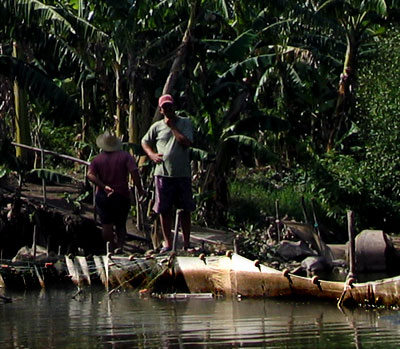
Fortunately, as we distanced ourselves from the bay, the mangroves started to thin out and be replaced by more interesting trees, and then a few habitations. That river was not in use by boats: there were nets everywhere, and in some places there were rocks built up to channel the water through the nets. Every fisherman told us they were trying to catch fish as well as anguilas, which we later figured out meant eels.
One would think they were mainly fishing for the fat, long eels, but in other nets (not pictured) they were it trying to catch them very young, when they were just an inch long. They’d catch them by the hundreds and fry ‘em all up at once. This sounds pretty disgusting to me, but we never did get to try it to find out for sure.
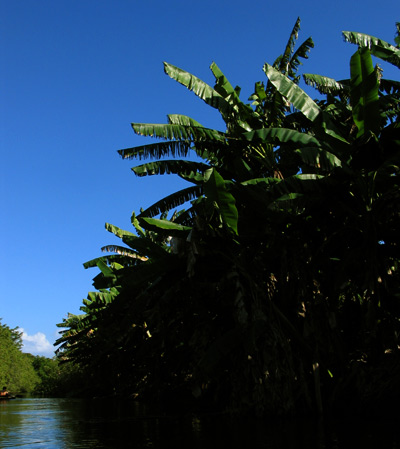
Soon before the bridge we started having to really watch out for the sparse but threatening rocks just under the surface of the water. The closer to the bay we were, the more affected by the tide the river would be, and we were concerned that on the way back the tide might make those rocks even more unavoidable.
After the bridge the river was very, very shallow. This didn’t seem to have anything to do with the tide, but more with the lack of rain we kept hearing about. Fisherman Buddy and others had all told us we’d never be able to paddle past the bridge. Of course we did anyway: we only needed to draught a few inches, and we still hadn’t learned to fear the rocks.
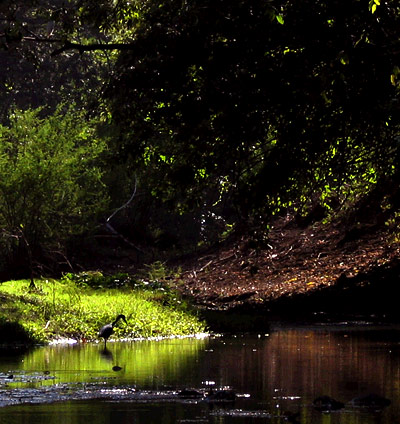
The skin on the Folbot Coopers seemed thinner than that on the Yukon I’d bought a few months before and which I’d already used in all sorts of crazy conditions. That yak had always seemed very tough, and no rock hits ever took significant chunks out of its hide. With the Cooper, though, I had some doubts.
In any case, we kept advancing up the river, moving slow in case we hit rocks. Both of us scraped many times, but always at low speeds, and we’d have time to lift our butts, lean, or stop before significant damage was done. This was until later in the afternoon, when the tide had brought the water level down even more, and Jay was paddling fast back and forth along one stretch he thought was safe. He was trying to expel his pent-up energy while I loitered taking pictures. Distracted for a moment, he hit a barely submerged rock dead on and at almost full speed. This accompanied by much wincing.
Now, while it may be true that the Cooper was clearly never intended for that kind of river kayaking – the kind with rocks - there is simply no way to keep a paddler from exploring such enticing waterways. It was with much frustration that we worried about the thin skins of these boats. Worrying takes a significant bite out of the fun of an activity.
We’d seen a lot that day. The river had not failed to amaze us. The further up we’d gone, the narrower and rockier and more interesting it had become. It had been absolutely glorious. The sun was getting low, and although we’d been mostly protected from it, the wind had clearly never died down. So we decided not to bother with going all the way back down the river and recrossing the bit of bay. We had folding kayaks! We’d return to Gibara by road. We pulled just down from the bridge, out on a little piece of flat land, hidden from the road. We lay our boats out to dry. We flipped them over to inspect for any rock damage.
We both had a few small scratches, mostly only on the surface, but a couple had disconcertingly exposed some of the fibrous fabric beneath the rubbery coating. But there was worse on Jay’s: where he’d rammed it there were major scratches and even a few miniscule holes you could see right through. These would certainly leak, albeit very slowly.
The thinness of the skin would not be a huge problem if it weren’t for the fact that you also need to have a frame and, well, weight in the boat! With a hit against the skin where there is nothing pressing against it from the inside of the boat (such as the frame), the skin just gives a little, then bounces back, and no damage is done. This is the ideal scenario and the reason why folding kayaks can mostly get away with using a thin hull.
The Cooper, however, has a single “keel longeron” running along the bottom of the boat (the Yukon sort of has two side by side). The negative effects of this are twofold.
First off, sitting for a few hours on the seat that comes with the boat, the tube starts to dig right into your tailbone, making you wish you had some more padding down there.
Secondly, and pertinent to this discussion, the keel of the boat is the most likely strip of hull to hit scuffy stuff underwater. The fact that there is an aluminium tube taking all sorts of weight means that when it does get hit, the fabric doesn’t have nearly as much give, and in resisting some damage is almost certain to occur.
I’ll cut to the conclusions we came to about this “problem” right here and now, because I feel it is very important to the workability of the fantasy of being able to literally backpack with a kayak anywhere on earth.
My Yukon had engendered a deep love for folding kayaking, and for Folbot for making it affordable, but there are a number of things about the Cooper which initially disappointed me. One of these things was the seemingly thinner skin, but I can only assume that this was done consciously by its ingenius designer, and with considerably more wisdom than I can ever aspire to. It must have been part of the continuing effort to shave pounds of its weight, and ultimately make it all fit into one bag. And since this is what makes it all possible, one must simply learn to cope with the consequences of it being as light as it is. To this end, the next day Jay dug out the little repair kit and applied a patch to the most affected area. It was incredibly easy, only took a few minutes, and the result looked permanent and tough. Over the course of the trip we each applied a number of patches (which were always just where the longerons were), and by the end of it all we felt reasonably comfortable in the knowledge of this as a necessary maintenance which is a necessary effect of having such an eminently portable and useful boat. Applying these patches is just a fact of life if we want to be able to explore extremely shallow and rocky rivers.
That said, next time I will try to remember to get a bunch of the hull material and pre-patch the hull at least along the entire “keel”, and perhaps even along where the other two bottom longerons are. I will also consider the pros and cons of doing it on the inside of the hull, too, rather than on the outside where it might cause a little drag, or get where the edges might get caught on submarine matter. This would be a highly sensible preventative measure, as it seems obvious that eventually patches would end up on all those areas anyway.
We reasoned out all these things over the course of the trip, but that day by the side of the river in Gibara it was fairly depressing to consider that we had decided to undertake such an expedition with such fragile apparatus. That night, though, we had Alberto’s delectable shrimp in sauce for dinner, and we recollected the joys of the day with satisfaction.
It had been a success, yes, but we still had coastal sea paddling as our main goal, so all this just postponed our ambitions. The positive side was that we were finally getting our boats wet, and we were beginning to think we’d have to grab any and all possible opportunities to do this.
We resolved to do the same the next day, on the second river. I went out and found Fisherman Buddy, told him about our adventures, and invited him to try and come with us the next day.
Wednesday, November 03, 2004
Part 4 - Bayamo to Antilla
The next night we agonized over the map we’d recently proven had omitted one of the countries largest fishing reservoirs. We tried to supplement its lies with the misguided guidebook. We knew we wanted to get away from this area and to try getting in the water some other way. So, we thought maybe we’d give the rivers a rest and head for a coast, any coast. In this random and desperate way we came up with the Atlantic coast village of Antilla. It wasn’t listed in our guidebook, but so what? At that moment it looked delicious, on our map, at the top of a bay with lots of little inlets and interesting looking coastline. The map legend indicated that it was probably mostly mangroves or swamp, but having been assured there were no carnivorous reptiles way over there, we optimisticized that mangroves would probably be fun to paddle around, anyway.
But how would we get to this place? It looked a little remote. We would have to go up to Holguin, probably, then perhaps towards Banes. But we didn’t want to go as far as Banes. It looked like one would have to get off the bus about 15 km before Banes, at a crossroads with the highway to Antilla. But gettings to Banes didn’t look easy even from Holguin. Perhaps we’d have to take a bus to Gaudalavaca, which one might think would be easy, being a major resort area. Then from there we might be able to get another, similar bus to Banes. Banes, at least, was only 15 km from the crossroads to the highway to Antilla.
In other words, we thought we might end up spending a couple of days trying to take buses and hitchhiking our way to Antilla. I wasn’t even sure that the very first step we’d postulated, which was going to Holguin, would even work. The system of the country seemed back then to conspire against us. In Cuba, as of this writing, the tourism infrastructure for backyaking packers is not in place. The tourist buses run very infrequently, and the tourist taxis are expensive.
We asked Fernando to call the bus terminal for us, to find out those infrequent bus times. We didn’t like the sounds of the times of day, nor the price. And what after Holguin? There were also the non-tourist buses, the Astro line, which were less infrequent and less costly, but didn’t go to Holguin or some other such problem. We discussed alternatives with Fernando. He suggested un coche particular, which means private car, and we liked that idea. He made a phone call and came back with the outrageous figure of $45, which we didn’t like. Okay, the route would be slow and complicated by bus, but in the end it didn’t look like it would even take two hours driving to get us there. We wouldn’t fall for that swindle!
We declined. To our surprise, instead of the person at the other end of Fernando’s phone making a counteroffer, the conversation just ended. We hoped we hadn’t burned our bridge before crossing it.
We sat with Fernando and discussed alternatives. Oddly, he didn’t suggest hitch-hiking, which we later discovered is possibly the easiest way to get around Cuba. But he did describe two state-operated ways of getting around. One is in the trucks, los camiones, that sounded like they left quite frequently, in most directions, and which cost mere pennies. They must have their gasoline subsidized, or it couldn’t work, but much is this way on that island. In Bayamo, the trucks left from around the bus terminal when they were full. Probably 30 or 40 passengers would be packed like merry sardines into the covered cargo section of these large mantransporters.
Another method of travel is with los Amarillos, meaning the Guys in Yellow. This one is brilliant. There are Amarillos stations at the side of every major road leaving every major town. If any citizen would like to journey in that direction, they just go to the appropriate Amarillos spot and get in line. The Guys in Yellow enforce the rule that all state vehicles must stop as they leave town and take as many passengers as there are empty seats. Apparently, it’s best to show up early in the morning. There is such little traffic in Cuba that “rush hour” is the only time of day to reliably see any vehicles at all.
These methods sounded interesting, and thus tempting, but in the end we decided that $45, though it seemed a little expensive for the distance, was really nothing when we considered it brought us right to where we could start paddling, as quickly as possible and in comfort. We apologetically requested Fernando to call his friend back and say we would accept the offer.
We also had some incredible ice cream that night. It wasn’t at all creamy, and it wasn’t unnaturally sweet, and it cost about a nickel for a cone. You often have to line up for ice cream.
The next day we had our first taste of travelling in private cars. Our driver was a young schoolteacher, as was his girlfriend who rode shotgun. We began to agree on some kind of story in case they were stopped by the police. We heard, over and over again throughout our stay in Cuba, whenever we’d take private cars, about the famous 1500 Peso fine that a driver can get for not being licenced to accept money for driving someone around. This equates to about $60. Therefore, a $45 “fare” is a gamble that could potentially lead to a loss, but most likely to a decent gain. The price of petrol cannot be discounted either, as it is very high at sixty cents a litre. Nor the age and size of the car and how much gas they consume. There are newer cars in Cuba, like Toyotas and Peugeots, which aren’t bad. The older ones are Ladas and other communist brands, and finally the oldest are all the many American cars from the 40’s and 50’s. But even if they spent $30 or more in gasoline, the gamble was worth potentially taking $15 home. A teacher may make that much money in a month.
So our story, in case stopped by the police, to perhaps give them a better chance of not receiving the fine, was that we were friends from before, and we’d met in chat over the internet. The guy happened to teach Computer Science and Mathematics, so it might be plausible.
We did end up driving right through Holguin, and then into the hills to the east. The drive was through the most beautiful countryside we’d seen, certainly more topologically eventful than we’d seen yet in Cuba. We’d spent hours upon hours staring at the flat countryside we passed during that marathon train ride. The most remarkable things had been that it seemed like there was hardly any large-scale agriculture and that there are dozens of buzzards patrolling any given section of sky in central Cuba.
But there, deep in El Oriente, as we drove with the teachers, the scene had changed. Rolling hills, lush forests, small farms, horses, goats, old guys with big cigars. Absolutely gorgeous. Anyone that’s ever thought it would be pleasant to “retreat” to a pure and simple life in rusticity would feel it and Know.
By the time as we made the turn onto the road to Antilla, the scene had changed again. Our first view of the sea outside of Havana was as we came over the last foothillock and we descended into an endless and perfectly level plain. These featureless flats merged into monotonous mangroves and onto a broad bay. My heart sank, but I made an outward show of enthusiasm for the sake of morale.
We rolled into town and our driver started asking around for a casa for us. We always made this agreement as part of the deal when arranging a private car. Of course, another standard part of the whole transaction is that payment is made to the driver right near the end of a trip, but before actually arriving in the destination town. That way no one would witness the money changing hands.
But in Antilla, no one he asked about a casa really seemed to have any ideas. Finally, one passerby, after glancing inside the car at us, doubtfully suggested a woman’s house further on. The whole town is strung out along the single road that comes out to find Antilla on its little peninsula. This road leads only to Antilla. Antilla is on the way to nowhere.
Then it expanded into a few parallel roads and we stopped at the house we’d been directed to. There was a sign above the door that looked just like the standard symbol for a licenced casa, one tent inside another, only it was red. The ones we’d seen had always been green. We sat in the car as buddy went to the door and knocked. After a desperate pause, she showed her head, and we watched him explain and point to us in the car. This is when she started shaking her head, a negation that became the tone for our stay in Antilla. They talked for a while, though, before she ducked back inside, still shaking her head. There was no question of her agreeing to our staying there.
The red logo means it’s a casa licenced for Cubans only. But one of the ideas she’d had was that we try the town’s only hotel. So, our driver, starting to be visibly frustrated about not being to easily dump us off, probably worried that the longer he loitered the more likely he’d get busted, set off for the centre of the town. He left the motor running as he ran into the hotel.
He came out less than a minute later, got back in the car and started driving again. He said the hotel was full and in any case didn’t take foreigners. Great. He then started saying that the old woman had suggested that we go to the central square and ask around for someone who might put us up. He was driving us away from that square, but only just far enough so that there weren’t so many people around to see us get out of his car with all our bags.
And before we knew it, there we were standing by the side of a sideroad in Antilla, and he was driving off, having accomplished to his satisfaction what we’d asked him to do. Later we’d be very annoyed with him for having “abandoned” us, but after all it was we that had had the crazy idea of going there, and there we were.
First we discussed going straight to the water, assembling and packing our boats and lighting the hell out of that dead-end place. It was already past two o’clock, and we’d never packed our boats before, so, realistically, we wouldn’t be setting out until 3:30 or 4:00, which seemed to be a bit chancy considering we had no idea where we were going to paddle from there. It is totally dark in Cuba by 7:00 pm. It was then that I found out that Jay hadn’t been too excited by the look of the bay, either, that his heart had sunk, too, when we’d first come over that hill and been faced with our prospected coastline.
Then Jay had the counter-idea that we could go directly to the hotel, set our bags down at the reception, and begin reasoning/pleading with them. Surely they’d take pity on us and we’d all come to an arrangement where someone made some money and we got shelter. Then we could circulate and get some local information on the bay and the surrounding coast.
It was a great plan that suffered only by not working at all. We ended up stranded in the hotel’s reception, the stone-faced bureaucrat on the other side of the desk steadfastedly pitiless. Before long we’d attracted the attention of a local drunk whose English was the best we’d heard in Cuba. In spite of this, something about him unnerved the both of us. Maybe it was the innumerable crude tattoos he had, including many phrases in Spanish. Que me mira? said one on his neck, I think. In fact, when we told him we were from Canada, he said “Oh, I have many friends from Canada. I love Canada!” and rolled up his shirt-sleeve. He was one of the few men in Cuba not wearing a tank-top, and on his upper arm he had a tattoo of the flag of Canada. He’d never been there, though, and combined with our plight it all added up to being very weird.
He was disconcertingly observant and intelligent and he seemed to have some kind of solution for every impossible query we came up with to get rid of him. For example, he had this radical idea to get us accomodated: demand to speak to someone from the government and tell them that we’re stuck in their town and have nowhere to sleep. He said that it would be the state’s responsibility to take care of us. It was illegal for foreigners to end up sleeping outside.
We soon noticed that we had used illegal transport to get there, there was no legal place for us to stay, nor was there a legal way for us to leave. The latter because there were no buses and certainly no tourist taxis. We were told while hanging out in the reception that Antilla gets maybe 4 or 5 foreigners coming through every year. It’s no wonder they didn’t have a clean way to handle us.
Cuba is in a transitory phase right now with respect to the kind of “backpacker” travel Jay and I were attempting. From my understanding, until recently there were tight controls over the movements of foreigners in Cuba. Travel within the country meant being a part of a tour, no alternatives. Now, with the Cold War finished and so on, there are far less limitations, but some of the mentality and previous rules still remain, perhaps illogically. It was no problem for us to be in Antilla, just a problem for us to get there, stay there, and leave there.
I’m sure we could have found someone to take a chance and put us up, but the guy with the tattoos, and later his brother, the Canadiana lunatic, were really setting us on edge. Everything pointed at Antilla being the wrong place for us to be, and little by little we were being led further into Freakedoutland. Jay and I started talking to each other in French in an attempt to communicate our mutual distaste for our situation, only to find tattoo-boy’s brother replying to us that he also spoke French. Creepier and creepier.
By then we were determined to find a car out of there, to anywhere, and we had our first taste of having one car owner after another turn us down, without even discussing price, because of a fear of getting caught by la policia. We took turns going to the square and looking for cars. Jay had found one guy that had said he’d do it, but he’d never shown up to get us. We thought the likelihood of scoring a ride, even the measly 15 km to Banes, was becoming more and more remote. Surely, by now, everyone in town must know we were there, which we imagined would make it even more difficult for a driver to get away with it. The day waned.
(For those impatient kayaker readers, be assured that in the next section we finally get on the water. And for those that don't care about that, first of all, shame on you, and secondly, be patient and assured that we soon got into much more trouble!)
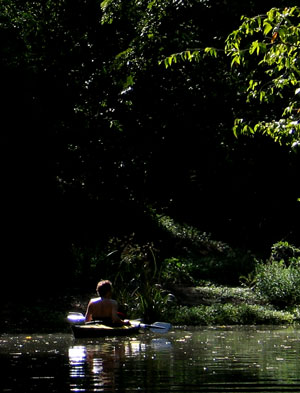

-T.jpg)

